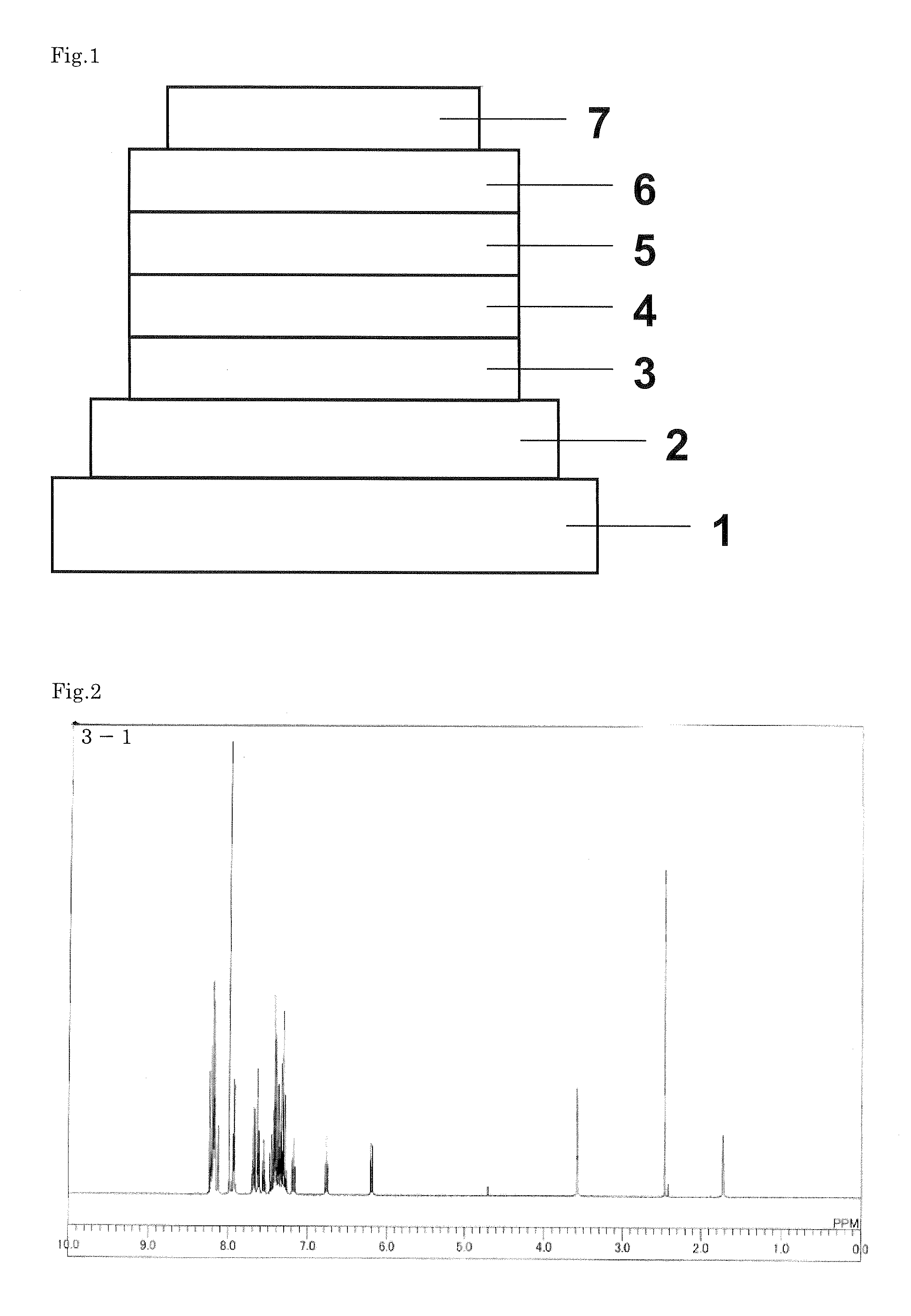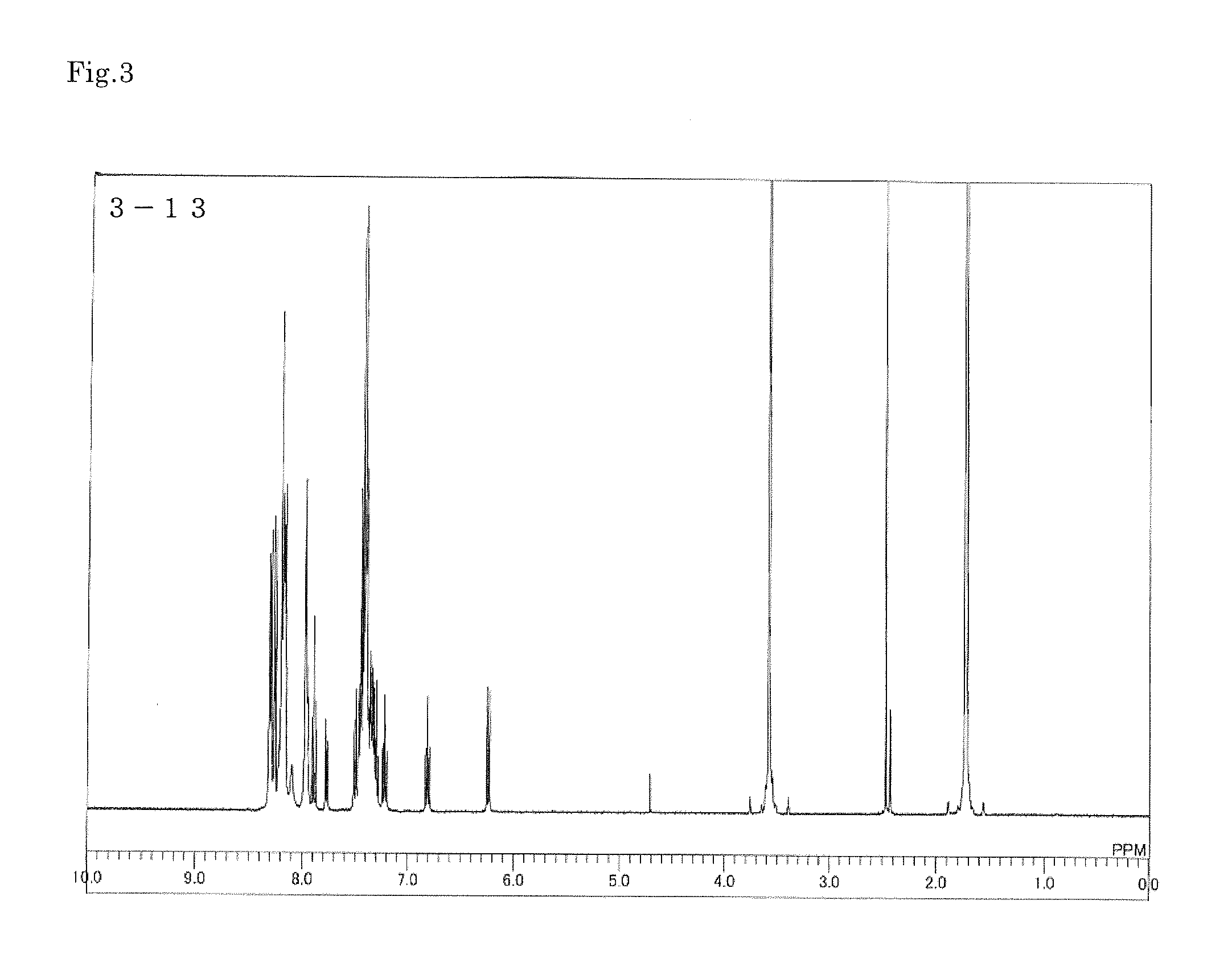Organic electroluminescent device comprising an organic layer containing an indolocarbazole compound
an electroluminescent device and organic layer technology, applied in the direction of luminescent compositions, organic chemistry, chemistry apparatus and processes, etc., can solve the problems of inability to disclose the use of aromatic hydrocarbon groups as linking groups, too failed to emit light at high efficiency, and excessive holes to flow out to the side of the electron-transporting layer, etc., to achieve good injection and transportation characteristics of holes and electrons, improve the probability of their recombination, and high durability
- Summary
- Abstract
- Description
- Claims
- Application Information
AI Technical Summary
Benefits of technology
Problems solved by technology
Method used
Image
Examples
synthetic example 1
Synthesis of Compound 3-1
[0100]
[0101]
[0102]Under a nitrogen atmosphere, 10.0 g (0.039 mol) of 5,12-dihydroindolo[3,2-a]carbazole (Compound IC-1), 39.8 g (0.20 mol) of iodobenzene, 6.2 g (0.098 mol) of copper, 8.1 g (0.059 mol) of potassium carbonate, and 200 ml of tetraglyme were mixed with stirring and the mixture was heated to 190° C. and stirred at this temperature for 24 hours. The reaction solution was cooled to room temperature and the copper and inorganic matter were separated by filtration. To the filtrate was added 200 ml of water, the mixture was stirred, and the precipitated crystal was collected by filtration. The crystal was dried under reduced pressure and purified by column chromatography to yield 9.7 g (0.029 mol, 75% yield) of Intermediate A as a white powder.
[0103]Under a nitrogen atmosphere, 25.0 g (0.075 mol) of Intermediate A, 25.6 g (0.066 mol) of 4-(3-bromophenyl)-2,6-diphenylpyridine, 25.5 g (0.13 mol) of copper iodide, 31.0 g (0.22 mol) of potassium carbonat...
synthetic example 2
Synthesis of Compound 3-13
[0105]
[0106]Under a nitrogen atmosphere, 9.9 g (0.039 mol) of Compound IC-1, 14.6 g (0.038 mol) of 4-(3-bromophenyl)-2,6-diphenylpyridine, 13.5 g (0.071 mol) of copper iodide, 16.6 g (0.12 mol) of potassium carbonate, and 350 ml of 1,3-dimethyl-2-imidazolidinone were mixed and the mixture was heated at 185° C. for 30 hours with stirring. The reaction solution was cooled to room temperature and inorganic matter was separated by filtration. The filtrate was added to 4,000 ml of water, the mixture was stirred, and the precipitated crystal was collected by filtration. The crystal was dried under reduced pressure and purified by column chromatography to yield 20.5 g (0.036 mol, 94% yield) of Intermediate B as a white powder.
[0107]Under a nitrogen atmosphere, 19.1 g (0.034 mol) of Intermediate B, 12.9 g (0.034 mol) of 4-(3-bromophenyl)-2,6-diphenylpyridine, 12.2 g (0.064 mol) of copper iodide, 15.8 g (0.12 mol) of potassium carbonate, and 300 ml of 1,3-dimethyl-2...
example 1
[0110]The constituent layers were deposited in thin film by the vacuum deposition process at a degree of vacuum of 4.0×10−5 Pa one upon another on a glass substrate on which a 110 nm-thick indium tin oxide (ITO) anode had been formed. First, copper phthalocyanine (CuPC) was deposited on the ITO anode to a thickness of 25 nm. Then, 4,4′-bis[N-(1-naphthyl)-N-phenylamino]biphenyl (NPB) was deposited to a thickness of 40 nm as a hole-transporting layer. Next, Compound 3-1 obtained in Synthetic Example as a host material and tris(2-phenylpyridine)iridium(III) (Ir(ppy)3) as a phosphorescent dopant were co-deposited on the hole-transporting layer from different deposition sources to a thickness of 40 nm as a light-emitting layer. The concentration of Ir(ppy)3 in the light-emitting layer was 10.0 wt %. Next, tris(8-hydroxyquinolinato)aluminum (III) (Alq3) was deposited to a thickness of 20 nm as an electron-transporting layer. Further, lithium fluoride (LiF) was deposited on the electron-tr...
PUM
| Property | Measurement | Unit |
|---|---|---|
| peak emission wavelength | aaaaa | aaaaa |
| work function | aaaaa | aaaaa |
| transmittance | aaaaa | aaaaa |
Abstract
Description
Claims
Application Information
 Login to View More
Login to View More - R&D Engineer
- R&D Manager
- IP Professional
- Industry Leading Data Capabilities
- Powerful AI technology
- Patent DNA Extraction
Browse by: Latest US Patents, China's latest patents, Technical Efficacy Thesaurus, Application Domain, Technology Topic, Popular Technical Reports.
© 2024 PatSnap. All rights reserved.Legal|Privacy policy|Modern Slavery Act Transparency Statement|Sitemap|About US| Contact US: help@patsnap.com










